#Vaz Lobo
Explore tagged Tumblr posts
Text
Okay enough fooling around here are the actual gay wolves


Resting "what do i see on this man" face
#i mean yeah death x the other wolf from shrek is nice but... mr wolf is also right there#but now that i think of it... death has two hands 👁️👁️#anyways that's not the point#the bad guys#mr wolf#death puss in boots#puss in boots death#puss in boots the last wish#lobo puss in boots#puss in boots lobo#what's his actual name tho lobo or death?¿#vaz sketches ✨✨#also fun fact!! i thought of making the 'me and the bad bitch i pulled' meme before knowing there was actually a mr wolf version#i went to look up the meme to use it as ref and found a version of him and Diane lmao#lately I've been predicting the dumbest shit idk what's going on
139 notes
·
View notes
Text
Tóli César Machado - Noir (2023)
Noir é um novo disco de Tóli César Machado. Esse facto, por si só, merece-nos todo o respeito. No entanto, Noir não é tão dark quanto gostaríamos, nem se projeta como banda sonora imprescindível das nossas vidas em 2023.
Noir é um novo disco de Tóli César Machado. Esse facto, por si só, merece-nos todo o respeito. No entanto, Noir não é tão dark quanto gostaríamos, nem se projeta como banda sonora imprescindível das nossas vidas em 2023. Tóli César Machado é o pequeno-grande génio por detrás de uma das mais icónicas bandas portuguesas de sempre, os GNR. O que dizemos não é novidade para ninguém, mas é sempre…
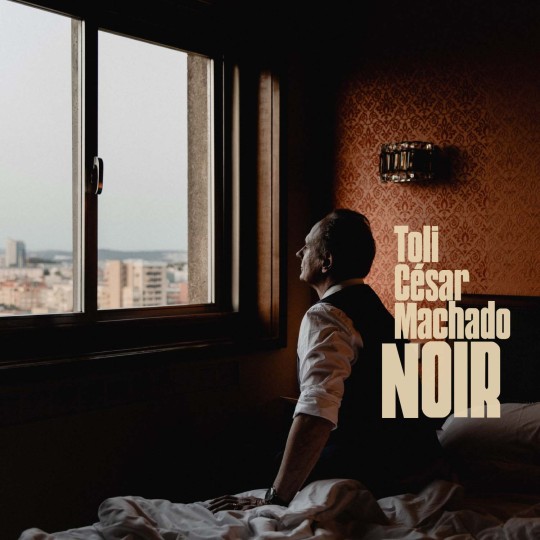
View On WordPress
0 notes
Text
19 anos
Eu me vi tão cansada da vida e, quando o choro saiu gritado e desesperado, percebi que, ao tentar ajudar a todos, fui me tornando a última prioridade. Como posso ser algo para alguém se não sou a minha própria prioridade? Acredito que, quando saí da casa dos meus pais em dezembro, senti que precisava dar certo e me tornar adulta de repente.
Sempre tentei ser uma adulta desde que me lembro. Quando falei para ele que, desde criança, sempre vivi na realidade, percebi como desde os 4 anos eu já precisava resolver problemas de adulto. Eu gostaria de pedir desculpas à Lana de 5 anos, mas peço à Lana de agora, chega de correr. Sempre idealizei ter 19 anos, ser jovem e apenas viver. Não posso viver presa às coisas que aconteceram. Já foi, está tudo bem se eu ainda precisar dos meus pais, se eu só precisar de um abraço. Falo tanto sobre ser o amor da vida de alguém, mas eu me odiava.....
Estou em paz. Não quero dizer que estou cega e vejo a vida como um arco-íris, mas, que se foda querer saber tudo da vida imagina saber tudo da vida ia perder a graça de viver. Quero viver o lado bom dos dias e, quando enfrentar o lado ruim, sei que vai passar, assim como tantos outros já passaram.
Obrigada. Está sendo bom te conhecer e não querer correr para saber se vai dar certo, até porque só tenho 19 anos e você também está resolvendo suas coisas pessoais. Gosto de como estamos crescendo separadamente para, que se um dia nos juntarmos, construirmos algo sólido que não caia com o sopro do lobo.
Sandrinha, obrigada por confiar em mim e viver essa aventura comigo. Nós vamos conseguir; já conseguimos.
Kaka, fico tão orgulhosa de você aqui no trabalho. Eu sabia que tinha escolhido a pessoa certa para focar nisso.
Beijinhos.
Lana Vaz
2 notes
·
View notes
Text
Identificar as etapas da evolução da literatura e as correspondências entre África, Brasil e Portugal é um processo abrangente que envolve reconhecer influências mútuas, contextos históricos e temáticas específicas que marcaram cada época. 1. Literatura Medieval (Séc. XII - XV)Mundial: Domínio da literatura oral e religiosa, com poemas épicos, crônicas, e obras de cavalaria. Influência dos valores feudais e da Igreja. Portugal: A literatura medieval portuguesa é marcada pelas cantigas trovadorescas (de amor, amigo, e escárnio) e crônicas reais. Obras como as Cantigas de Santa Maria e os registros de Fernão Lopes se destacam. Brasil: Não há produção literária no Brasil nesta época, devido ao período pré-colonial. África: Literatura predominantemente oral, com mitos, lendas e histórias transmitidas oralmente que preservam a cultura e identidade dos diversos povos. 2. Renascimento e Literatura Clássica (Séc. XV - XVI) Mundial: Redescoberta dos textos clássicos e valorização do humanismo, das artes, e da ciência. Surge a literatura renascentista com figuras como Dante, Petrarca e Camões. Portugal: Grande destaque para Os Lusíadas de Camões, que celebra as descobertas marítimas e a expansão de Portugal. Surge uma literatura que enaltece a pátria e o espírito aventureiro. Brasil: Início da colonização, com textos descritivos dos cronistas e cartas de viajantes, como a Carta de Pero Vaz de Caminha. África: Contacto inicial com a literatura ocidental através dos colonizadores europeus, mas a tradição oral continua sendo o principal meio de transmissão cultural. 3. Barroco (Séc. XVII) Mundial: Época de contrastes e complexidade. O estilo barroco reflete a crise espiritual da época e o conflito entre o sagrado e o profano. Portugal: Poetas como Padre António Vieira e Francisco Rodrigues Lobo expressam uma literatura marcada pela retórica rebuscada e pelos dilemas religiosos. Brasil: Surge a literatura barroca com destaque para Greg��rio de Matos e o Padre António Vieira, que abordam temas religiosos e sociais com uma linguagem rica em metáforas e ironia. África: A literatura escrita é praticamente inexistente, mas a oralidade permanece forte, enquanto o contato colonial afeta a cultura tradicional.
4. Neoclassicismo e Arcadismo (Séc. XVIII) Mundial: Retorno à simplicidade e aos valores clássicos greco-romanos, com uma poesia bucólica e racional. Portugal: O Arcadismo foca em temas rurais e naturais. O principal autor é Manuel Maria Barbosa du Bocage. Brasil: A Escola Mineira (Arcadismo) surge com poetas como Cláudio Manuel da Costa e Tomás Antônio Gonzaga, que idealizam a vida no campo e criticam o abuso de poder colonial. África: Presença cultural africana em obras brasileiras e portuguesas, enquanto o continente africano ainda permanece com uma literatura fortemente oral.
5. Romantismo (Séc. XIX) Mundial: Exaltação do individualismo, da natureza e da liberdade. Surgem temas nacionalistas e valorização da cultura popular.
Portugal: Almeida Garrett e Alexandre Herculano lideram o movimento romântico, com destaque para o nacionalismo e o medievalismo.
Brasil: O Romantismo brasileiro celebra a identidade nacional com autores como José de Alencar e Gonçalves Dias, que exploram temas indígenas e exóticos.
África: Início da escrita literária africana, embora ainda limitada devido ao domínio colonial. Há o início de uma literatura de resistência e identidade cultural.
6. Realismo e Naturalismo (Séc. XIX) Mundial: Movimentos que buscam representar a realidade de forma objetiva, abordando temas sociais e psicológicos.
Portugal: Eça de Queirós é a grande figura do Realismo português, com obras como Os Maias, que criticam a sociedade portuguesa.
Brasil: Machado de Assis se destaca, trazendo uma visão crítica da sociedade brasileira em obras como Dom Casmurro.
África: Literatura africana começa a questionar o colonialismo, mas a produção literária escrita ainda é limitada.
7. Modernismo (Séc. XX)Mundial: Quebra com a tradição, inovação na forma e no conteúdo, explorando temas como a alienação e o caos urbano.
Portugal: O Modernismo português é liderado por Fernando Pessoa e Mário de Sá-Carneiro, com grande experimentação linguística e introspecção.
Brasil: Semana de Arte Moderna de 1922 marca a ruptura com o passado e a busca por uma identidade nacional autêntica, com autores como Oswald de Andrade e Mário de Andrade.
África: O Modernismo se consolida com autores que abordam temas de identidade e independência. Surgem nomes como Agostinho Neto em Angola e José Craveirinha em Moçambique.
8. Literatura Contemporânea (Séc. XXI) Mundial: Diversidade de estilos e temáticas, com literatura digital, autoficção, e questionamentos sobre o futuro.
Portugal: Expansão de temas universais, como a globalização e a memória histórica, com autores como José Saramago e António Lobo Antunes.
Brasil: Literatura contemporânea aborda temas como urbanização, questões de gênero e minorias, com autores como Conceição Evaristo e Milton Hatoum.
África: Literatura africana reflete questões de identidade, pós-colonialismo e diáspora, com autores renomados como Mia Couto e Chimamanda Ngozi Adichie.
Essa correspondência entre as literaturas de África, Brasil e Portugal mostra como as fases e movimentos literários se entrelaçam, ao mesmo tempo que mantêm particularidades ligadas à história e à cultura de cada país ou região.

。。。。。。 。。。。。。 。。。。。。。。 。。。。。。 。。。
Glossário:
Arcadismo: Influência literária das Arcádias.
Colonialismo: Doutrina ou atitude favorável à colonização ou à manutenção de colónias.
Crónicas: História que expõe os factos em narração simples e segundo a ordem em que eles se vão dando.
Humanismo: Doutrina dos humanistas do Renascimento que ressuscitaram o culto das línguas e das literaturas antigas.
Idealismo: Sistema filosófico que encarece e afirma o valor da ideia.
Medievalismo: Fascinación o idealización de la Edad Media, frecuente en el Romanticismo, donde se retoman temas y personajes de ese período.
Mitos: Relatos tradicionales que intentan explicar fenómenos naturales, valores culturales o creencias religiosas de una sociedad.
Naturalismo: Corriente literaria del siglo XIX que intenta representar la realidad de forma detallada y científica, mostrando el entorno y la herencia como factores que determinan el destino humano.
Pós-colonialismo: Corriente de pensamiento que examina y critica las consecuencias del colonialismo, especialmente en términos de identidad cultural y social en los países que fueron colonizados.
Realismo: Movimiento artístico y literario que busca representar la realidad de manera objetiva, sin idealizaciones. Surgió en el siglo XIX y se caracteriza por abordar temas sociales y psicológicos.
Renacimiento: Movimiento cultural de los siglos XV y XVI que implica un "renacer" de las artes y el conocimiento clásico, destacando el Humanismo y los avances científicos.
Romanticismo: Movimiento literario y artístico del siglo XIX que exalta los sentimientos, la naturaleza, el individualismo y la libertad.
Trovadores: Poetas de la Edad Media que componían y cantaban poemas amorosos o satíricos. Las “cantigas trovadorescas” son un ejemplo en la literatura medieval portuguesa.
Vanguardismo: Movimiento artístico y literario del siglo XX que rompe con las normas establecidas, promoviendo la innovación en la forma y el contenido, y cuestionando temas sociales y culturales.

0 notes
Video
vimeo
MODALISBOA SINGULAR from ModaLisboa - Lisboa Fashion Week on Vimeo.
A 63ª edição da Lisboa Fashion Week realiza-se, em coorganização com a Câmara Municipal de Lisboa, entre os dias 10 e 13 de outubro de 2024. MODALISBOA SINGULAR é uma celebração da relação entre a capital e a Semana de Moda, produto de uma cidade efervescente, transformada e transformadora, brilhante e intercultural.
CAMPANHA MODALISBOA SINGULAR Agência: Havas Produção Executiva: Nuno Lobo, João Cabezas. Casper Films. Realização: Bruno Ferreira Direção de Fotografia: Bernardo Infante Fotografia: Marcus Sabah Assistentes de Realização: Ana Moreira e Carlos Malta Assistentes de Imagem: Fernando Tavares, Maria Inês Rodrigues e Catarina Santos Chefe de Produção: Mónica Figueira Coordenadora de Produção: Mónica Martins Location Manager: Andreia Monteiro Assistentes de Produção: Urshi Cardoso e Hugo Granjo Pasta PPM: Diana Oliveira Carrinha de Produção: David Almeida Direção de Arte: Marta Cruz Handyman: Ivna Carvalho Styling: Larissa Marinho assistida por Sofia Amaral Coelho Make-up: Joana Lopes, Catalina Canas, Sandra Alves e Marcelo Duarte para Antónia Rosa Studio Hair: Ana Fernandes, Nicole Francisco, Paulo Vieira e Edgar Santo para Helena Vaz Pereira/Griffe Hairstyle Chefe Eletricista: Sérgio Pontes Assistentes Eletricista: Tiago Jesus e Luís Carneiro Câmara: Planar | José Tiago Light/Grip: STP | Sérgio Pontes Material de Produção: New Play | David Almeida Editor: César Santos Pós-produção: Miguel Diogo Som: Som de Lisboa Grading: Bernardo Infante Música: MÁXIMO Casting: Ana Julia e Yanessa, Karacter; Mingze e Ezy, We Are Models; Diogo Faial, Gany Camara, Nikita e Elis Meeksa, Face; Sahil e Junior, Just; Ariel, Miriam e Aurora, Papaya. EQUIPA HAVAS CEO: Pedro Graça CCO: Paulo Pinto Diretor Criativo: José Vieira Diretora Criativa Digital: Margarida Pedreira Diretora de Contas: Maria João Ramos Diretora de Produção: Raquel Gomes da Costa Dupla Criativa: Rita Neves e Vasco Carvalho Diretor de Planeamento Estratégico: Gabriel Batista Account Manager Publicidade: Sofia Tavares de Carvalho Designer Digital: Guilherme Carvalho Arte-finalista: Nuno Nascimento
Agradecimentos: Lisboa Film Commission
0 notes
Text
Revista Mapas do Confinamento , a publicação do coletivo que representa uma série de talentos (onde estou incluído).
Faça o download gratuito no link no final do post
***
REVISTA MAPAS DO CONFINAMENTO
19 edições com colaborações de:
Ana Carvalho | Lelena Lucas | Teresa dos Santos | Paulo Kellerman | Ondjaki | Susana Piedade | Hirondina Joshua | Richard Zimler | Rafael Ibarra | Telma Tvon | Kátia Borges | Carla de Sousa | Ricardo Fonseca Mota | José Luís Jorge | Maria Teresa Horta | Maria João Cantinho | Heduardo Kiesse | Godofredo de Oliveira Neto | Ana Gilbert | José Luís Mendonça | Frankie Boy | Décio Zylbersztajn | Pedro Teixeira Neves | Deusa d'África | André Timm | Mélio Tinga | Eduardo Duarte | Ana Cristina Silva | Natália Timerman | Elísio Miambo | Goretti Pereira | Adriane Garcia | Hugo Mezena | Marcela Dantés | Zetho Cunha Gonçalves | Mónia Camacho | Sónia Silva | Ronaldo Cagiano | Rafael Vieira | José Alberto Postiga | Sónia Travassos | Alê Motta | João Nuno Azambuja | Alice WR | Amílcar Bettega | Emílio Tavares Lima | Domingos Lobo | Dirce Waltrick do Amarante | Renata Belmonte | Manuela Vaz | Julieta Massossote | Teresa Guerreiro | Sérgio Tavares | Tiago D. Oliveira | Almeida Cumbane | Ana Pessoa | Sara Bandarra | Claudia Nina | Henrique Rodrigues | Otildo Justino Guido | Harrie Lemmens | Olinda Gil | Patrícia Lavelle | Susana Gonçalves | Rafael Azevedo | Agnaldo Bata | Rui Zink | Katia Gerlach | Vanessa Vascouto | Teresa Afonso | João da Silva | Sébastien Rozeaux | Céline Gaille | Luísa Semedo | Mazé Torquato Chotil | Helena Machado | Sónia Queimado Lima | Luísa Ducla Soares | Aida Gomes | Eltânia André | Ana Moderno | Lahissane | Daísa Rizzotto Rossetto | Renato Tardivo | Ricardo Figueira | Marta Barbosa Stephens | Cristina Vicente | Ozias Filho | Nara Vidal | João Anzanello Carrascoza | Edmilson Mavie | Juliana Berlim | Gabriela Ruivo Trindade | Juliana Monteiro Carrascoza | Cristina Drios | Alex Andrade | Sónia Palma | António Ladeira | Sílvia Bernardino | Nuno Gomes Garcia | Simone Mota | Nuno Camarneiro | Lopito Feijóo | Thais Beltrame | Paulo Martins | Dominique Stoenesco | Luciana Grether | Catarina Gomes | Rita Reis | Sara Bandarra | Sónia Borges | Maraia | Inês Soares | Fátima Nascimento | Yara Kono | Ana Biscaia | Thais Beltrame | Luísa Portugal | Mafalda Milhões | Marta Madureira | Rachel Caiano | João Batista Melo | Helena Terra | Catarina Gomes | Mónica Brandão | Gabriela Silva | Rodrigo Tavares | Amosse Mucavele | Valério Maúnde | Carla Bessa | Sara F. Costa | Paulo Landeck | Samuel F. Pimenta | Paulo José Costa | Mário Araújo | Dora Nunes Gago | Rita Taborda Duarte | Kalaf Epalanga | Phoe McCallum
Download gratuito:
https://www.mapasdoconfinamento.com/magazine-portuguese
#oziasfilho#oziasfilhophotographer#cascais#portugal#fotografia#bnw#poesia#photography#retratos#cinema
0 notes
Text
MEGA OFERTA!!!!!
Localização: O imóvel está situado no bairro Vaz Lobo, próximo ao novo Polo da UERJ.
Características do Apartamento:
Área: O apartamento possui 86 metros quadrados.
Quartos: São 2 quartos.
Banheiros: Dispõe de 2 banheiros.
Sala: A sala é ampla e espaçosa.
Cozinha: A cozinha conta com armários planejados.
Área de Serviço: Há uma área dedicada para a lavanderia.
Dependência de Empregada: Ótimo para quem precisa de espaço extra.
Vaga na Escritura: Uma vaga de estacionamento está incluída.
Espaço Jardinado: Ideal para quem gosta de áreas verdes.
Área de Recreação Infantil: Perfeito para famílias com crianças.
Salão para Festas e Eventos: Ótimo para receber convidados.
Espaço Reservado para Churrasco: Ideal para momentos de lazer.
Privacidade: O condomínio é fechado, proporcionando segurança e tranquilidade.
Proximidade:
Comércio: Está próximo a todo tipo de comércio.
Mercadão de Madureira: Apenas 5 minutos de distância.
Condução: A poucos metros de pontos de transporte público.
Aceita Financiamento: Essa é uma ótima vantagem para quem deseja adquirir o imóvel por meio de financiamento.
Agende uma visita (21) 99522-9946 / 3798-9569
Vídeo: https://youtu.be/cPY0tOke_e0
#youtube#family#marketing#imobiliária#memes#administração#imoveis#tumblr milestone#university#home decor
0 notes
Text
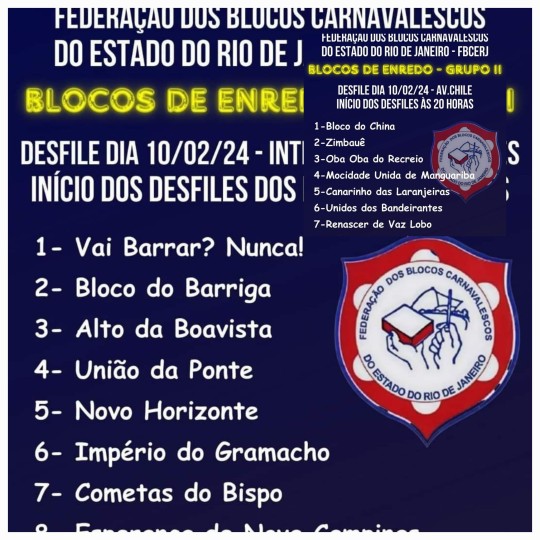

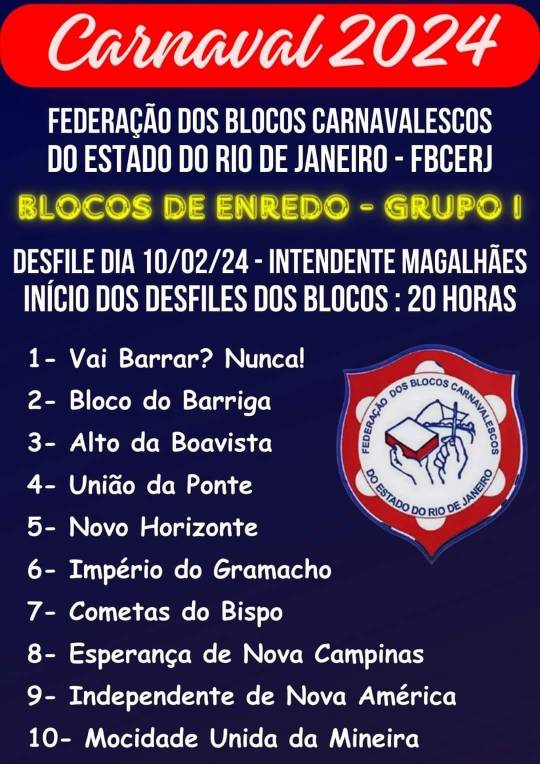
Federação dos Blocos Carnavalesco do Estado do Rio de Janeiro abre o carnaval da Intendente Magalhães e da Avenida Chile no dia 10 de fevereiro de 2024
Com 58 anos de fundação e muitos carnavais, a Federação dos Blocos Carnavalescos do Estado do Rio de Janeiro (FBCERJ) está pronta para abrir os desfiles carnavalescos dos blocos de enredo no sábado, dia 10 de fevereiro, a partir das 20 horas, na Estrada Intendente Magalhães, em Campinho, e na Avenida Chile, no Centro da Cidade.
A Federação dos Blocos de enredo, que é a instituição carnavalesca mais antiga em atividade do Estado do Rio de Janeiro, e comandada pelo presidente Luiz Pereira Duarte, mais conhecido como Luiz Cajá, será a responsável pelos 19 blocos de enredo que animarão os foliões no Carnaval 2024, sendo dez agremiações na Intendente Magalhães, e nove na Avenida Chile.
O presidente da entidade, Luiz Cajá, em reunião com os presidentes dos blocos de enredo na sede da entidade, ressaltou a importância de cada um no desfile de 2024, para a apresentação de um grande espetáculo.
Confira a ordem de desfiles dos blocos de enredo do Grupo I, na Avenida Intendente Magalhães, em Campinho: Vai Barra? Nunca!, Bloco do Barriga, Unidos do Alto da Boa Vista, União da Ponte, Novo Horizonte, Império do Gramacho, Cometas do Bispo, Esperança de Nova Campinas, Independente de Nova América e Mocidade Unida da Mineira.
Já a ordem de desfiles dos blocos de enredo do Grupo II, na Avenida Chile, no Centro do Rio, está assim definida: Bloco do China, Zimbauê, Oba Oba do Recreio, Mocidade Unida de Manguariba, Canarinhos das Laranjeiras, Unidos dos Bandeirantes, Renascer de Vaz Lobo, Amigos do Tinguá e Raízes da Tijuca.
Adriana Vieira
Assessora de Imprensa
Federação dos Blocos Carnavalescos do Estado do Rio de Janeiro
(FBCERJ)
Proibido a reprodução das imagens sem autorização expressa do autor Lei 9610 de Direito Autoral
0 notes
Link
#109anos#ANIVERSÁRIOPVH#celebra#destaque#HildonChaves#históriac#Município#obrasemexecução#R$270milhões
0 notes
Text
Trechos da Avenida Brasil são interditados para obras da Transbrasil #bolhaedu #bolhadev visite nosso portal de #noticias
Interdições começam nesta quinta-feira (9), às 22h. Até as 5h de sexta (10) haverá interdição total da pista lateral, sentido Centro, na altura da Estação BRT Benfica, para içamento da treliça do pórtico. A Avenida Brasil sofre várias intervenções, a partir desta quinta-feira (9), para realização de obras do corredor expresso do BRT Transbrasil. Confira as interdições: Entre os dias 9 e 11 de fevereiro, das 22h às 5h: interdição total da pista lateral, sentido Centro, na altura da Estação BRT Benfica, para içamento da treliça do pórtico; Entre os dias 9 e 13 de fevereiro, das 22h às 5h: interdição de 1 faixa na pista lateral, sentido Deodoro, entre as ruas Nova Jerusalém e a rua da Proclamação, para implantação de drenagem de água e esgoto; Entre os dias 9 e 16 de fevereiro, das 22h às 5h: interdição de 1 faixa por vez, na pista central, sentido Centro, entre Viaduto BRT Caju e o INTO para implantação de sinalização vertical; Entre os dias 9 e 21 de fevereiro, das 22h às 5h: interdição de 2 faixas por vez, na pista central, sentido Deodoro, entre o Canal do Cunha e a Estação BRT Rubens Vaz, para tratamento patologia piso rígido; A partir do dia 9 de fevereiro até o dia 4 de março, das 22h às 5h: interdição intermitente nas agulhas de acesso, em ambos sentindo, entre o Caju até Estação BRT Lobo Junior (Penha), para implantação de sinalização vertical. DESVIOS: serão realizados na própria via, nos trechos com estreitamento ou desviando para pista central/lateral. Sinalização específica será instalada para orientar e alertar os motoristas e as condições do trânsito serão monitoradas quanto a eventuais impactos.
0 notes
Photo

“...se me perguntam porque continuo no Exército respondo que a revolução se faz por dentro, explicava o capitão de óculos moles e dedos membranosos atrás do seu cigarro eterno...”
António Lobo Antunes, “Os Cus de Judas”; Miguel Nunes e João Pedro Vaz em “Cartas da Guerra”, de Ivo Ferreira (2016).
4 notes
·
View notes
Quote
A leitura é uma coisa que se educa. Que se ensina e que se aprende.
António Lobo Antunes
#António Lobo Antunes#as palavras não se afogam ao atravessar o atlântico#carlos vaz marques#entrevista
34 notes
·
View notes
Text
Lobeira
Wolf-herder, pieira/peeira, witch, wolf-keeper, corrilário, wolf fairy.
If you are the north or south of Portugal, in Brazil or other Portuguese speaking countries, you may hear these names.

Born from an uninterrupted line of six girls before her, turned by a faulty baptism ceremony or just by hearing the howl of a wolf who wants her, these girls and women protect the wolf pack they belong to until someone breaks their enchantment or maybe until seven years pass. Sources vary.
Like many others who turn into something not human, there is a rift between them and the society they live in. They don't belong in the human world, as they travel between several. In legends, this rift can be more subtle, with the girl getting up in the middle of the night to go do her wolf-herder thing, or it could be literal, with her living in a forest with the wolves.
Either way, far from society, maybe forever.
Sounds great! Where can I sign up? Such tragedies are these sad tales. Being an outcast in a small community, where people can’t mind their own business.
(I guess not sticking your nose where it doesn’t belong is a very Portuguese thing to do)
If you see them, they will either be turned into a full-on wolf to run with the pack or just do the fado in human form. In only one story I’ve seen one of these turn into a half-woman, half-wolf creature. Less animalistic than werewolves, lobeiras have some sort of control over their actions but don’t underestimate them, if you are a human and attempt mess with one, you’ll get hurt. Animals seem to be the only ones to witness the more caring side of them.
Still, they can be very kind, healing sicknesses and werewolf curses. They can be independent wild beings, servants to their packs, a werewolf or an evil spirit, or maybe incredibly clever leaders of their wolf packs. In some tales, a lobeira can even be a seductress that preys on wandering men to feed them to her wolves.
(Man, I want to be a lobeira)
Her wolves don't even need to be actual wolves, they can spirits or metaphors, and that fact, combined with the fact that they sometimes live in forests, makes some wonder if their mythological roots don't lie with classical nymphs. Who knows? These legends are too spread and old to identify their mythological origins, but we know that maybe tales of these creatures originated in Galicia.
In the end, stories about them are diverse but the formula is a tad repetitive:
A girl is found by a random villager who is very weirded out by seeing a woman who is apparently completely on her own (maybe even having strange fashion choices such as strange clothing and short hair) and shenanigans ensue. Things don’t not end well for one of the parties.
Either way, someone dies because these legends are supposed to be horror. Not enchanting fantasy or mysterious tales that fill your head with wonder. Horror. Some people may wonder why I'm choosing to write about wolf-fairies on Halloween week and this is why. These creatures have very grey morals, can be quite ruthless and selfish to humans, and are overall very associated with bloodshed. Don’t mess with a pieira, because if you don’t kill her, the last thing you’ll see is her and her wolves.

Sources: ‘‘Seres Mágicos em Portugal’‘ by Vanessa Fidalgo
''O lobo no imaginário popular'' by F. Álvares.
''Extraordinary children, werewolves, and witches in Portuguese folk tradition'' by Francisco Vaz da Silva
#creatures#Portuguese Creatures and Legends Galore!#Portugal#portuguese legends#legends#lendas portuguesas#lendas#portuguese folklore#folklore#folclore#folclore português#myths#mythology#mitos#mitologia#lobo#wolf#lobos#wolves#fadas#fairies#fado#man these legends could do some really nice stories#where are my urban fantasy people at?
33 notes
·
View notes
Photo

#Ubuntu . Estamos participando dessa campanha potente e linda de promoção ao #afroturismo e por um mundo #antirracista. . Você sabe o que é #AFROTURISMO? . Dentro do Turismo Cultural temos uma infinidade de experiências de acordo com a história e a cultura vivida de um determinado grupo étnico. Sendo assim, o afroturismo é o ramo que valoriza o patrimônio material e imaterial afrobrasileiro. . Guiadas Urbanas nasce, há quase 8 anos atrás, de um idéia de trazer visibilidade e valorização a espaços urbanos do subúrbio e da periferia através do turismo apresentando as memórias, as vivências e os patrimônios locais e afetivos. . Nosso primeiro freetour suburbano foi apresentando a História do Bairro do Méier e terminando em uma roda cultural de jongo do grupo #Afrolaje. . A idéia era essa! Mergulhar, se permitir e conhecer sem nenhum compromisso. Experimentar as nossas vivências para mostrar o quão rico ele é. . O único compromisso que temos é te apresentar um Rio além dos cartões postais! . Quando começamos a validar nosso serviço o turismo ainda estava focado no eixo Centro-Zona Sul e a Barra da Tijuca ainda querendo se achar um espaço em exceção a Zona Oeste (risos). . Imaginar passeios turísticos pelo bairro do subúrbio da Penha, de Madureira, Méier, Marechal, Cascadura, Irajá, Bangu, Realengo, Quintino, Vaz Lobo, Campo Grande, Santa Cruz, Engenho de Dentro, Vila Isabel, Grajaú e demais subúrbios tem sido uma caminhada linda. . Quantas potências estão surgindo e potencializando o território onde vivem. . Tem espaço pra todo mundo, mas é preciso respeitar o protagonismo e o lugar de fala de cada grupo engajado nessa valorização. . Se liga nessa palavra, porque hoje vai ter chuva de #afrobrasilidade no seu feed com muit@s colegas aqui potencializando o que fazem de melhor dentro do afroturismo. . Quer apoiar voluntariamente o Afroturismo com uma imagem e um post semelhante a este? Envie e-mail para [email protected] e se aquilombe com a gente em prol de um #turismoantirracista. ✊🏼✊🏽✊🏾✊🏿 🤎🖤🤎🖤🤎🖤🤎 #afrotourism #antirracismo #tourmadureira #tourculturalsuburbano #aquilombamento #subúrbiocarioca #culturaafrosileira #jongo #sambaderoda #capoeira https://www.instagram.com/p/CGX7UmNJmgs/?igshid=hevunyvna34i
#ubuntu#afroturismo#antirracista#afrolaje#afrobrasilidade#turismoantirracista#afrotourism#antirracismo#tourmadureira#tourculturalsuburbano#aquilombamento#subúrbiocarioca#culturaafrosileira#jongo#sambaderoda#capoeira
1 note
·
View note
Text
15th King of Portugal (6th of the Aviz Dynasty): King João III of Portugal, “The Pious/ The Colonizer”

Reign: 13 December 1521 – 11 June 1557 Acclamation: 19 December 1521 Predecessor: Manuel I
John III (7 June 1502 in Lisbon – 11 June 1557 in Lisbon) nicknamed The Colonizer ("o Colonizador") was the King of Portugal and the Algarves from 13 December 1521 to 11 June 1557. He was the son of King Manuel I and Maria of Aragon, the third daughter of King Fernando II of Aragon and Queen Isabel I of Castile. João succeeded his father in 1521, at the age of nineteen.
During his rule, Portuguese possessions were extended in Asia and in the New World through the Portuguese colonization of Brazil. João III's policy of reinforcing Portugal's bases in India (such as Goa) secured Portugal's monopoly over the spice trade of cloves and nutmeg from the Maluku Islands, as a result of which João III has been called the "Grocer King". On the eve of his death in 1557, the Portuguese empire had a global dimension and spanned almost 1 billion acres (about 4 million square kilometers).
During his reign, the Portuguese became the first Europeans to make contact with both China, under the Ming dynasty, and Japan, during the Muromachi period. He abandoned Muslim territories in North Africa in favor of trade with India and investment in Brazil. In Europe, he improved relations with the Baltic region and the Rhineland, hoping that this would bolster Portuguese trade.

João, the eldest son of King Manuel I to his second wife Maria of Aragon, was born in Lisbon on 7 June 1502. The event was marked by the presentation of Gil Vicente's Visitation Play or the Monologue of the Cowherd (Auto da Visitação ou Monólogo do Vaqueiro) in the queen's chamber.
The young prince was sworn heir to the throne in 1503, the year his youngest sister, Isabel of Portugal, Empress Consort of the Holy Roman Empire between 1527 and 1538, was born.
João was educated by notable scholars of the time, including the astrologer Tomás de Torres, Diogo de Ortiz, Bishop of Viseu, and Luís Teixeira Lobo, one of the first Portuguese Renaissance humanists, rector of the University of Siena (1476) and Professor of Law at Ferrara (1502).
João's chronicler António de Castilho said that, "Dom João III faced problems easily, complementing his lack of culture with a practice formation that he always showed during his reign" (Elogio d'el rei D. João de Portugal, terceiro, do nome). In 1514, he was given his own house, and a few years later began to help his father in administrative duties.

At the age of sixteen, João was chosen to marry his first cousin, the 20-year-old Leonor of Austria,

eldest daughter of Philip the Handsome of Austria-Burgundy

and Queen Joana of Castile,
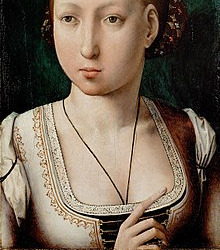
but instead she married his widowed father Manuel. João took deep offence at this: his chroniclers say he became melancholic and was never quite the same. Some historians also argue this was one of the main reasons that João later became fervently religious, giving him name the Pious (o Piedoso).
On 19 December 1521, João was crowned king in the Church of São Domingos in Lisbon, beginning a thirty-six-year reign characterized by extensive activity in internal and overseas politics, especially in relations with other major European states. João III continued the absolutist politics of his predecessors. He called the Portuguese Cortes only three times and at great intervals: 1525 in Torres Novas, 1535 in Évora and 1544 in Almeirim. During the early part of his reign, he also tried to restructure administrative and judicial life in his realm.
The marriage of João's sister Isabel of Portugal to Holy Roman Emperor Charles V,
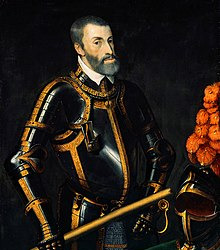
enabled the Portuguese king to forge a stronger alliance with Spain and the Holy Roman Empire. To strengthen his ties with Austria, he married his maternal first cousin Catherine of Austria, younger sister of Charles V and his erstwhile fiancée Leonor, in the town of Crato. João III had nine children from that marriage, but most of them died young. By the time of João's death, only his grandson Sebastião was alive to inherit the crown.
The large and far-flung Portuguese Empire was difficult and expensive to administer and was burdened with huge external debt and trade deficits. Portugal's Indian and Far Eastern interests grew increasingly chaotic under the poor administration of ambitious governors. João III responded with new appointments that proved troubled and short-lived: in some cases, the new governors even had to fight their predecessors to take up their appointments. The resulting failures in administration brought on a gradual decline of the Portuguese trade monopoly. In consideration of the challenging military situation faced by Portuguese forces worldwide, João III declared every male subject between 20 and 65 years old recruitable for military service on 7 August 1549.
Among João III's many colonial governors in Asia were Vasco da Gama,

Pedro Mascarenhas,

Lopo Vaz de Sampaio,

Nuno da Cunha,

Estêvão da Gama,

Martim Afonso de Sousa,
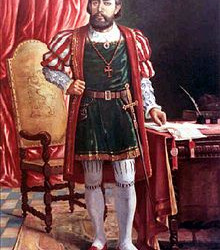
João de Castro

and Henrique de Meneses. Overseas, the Empire was threatened by the Ottoman Empire in both the Indian Ocean and North Africa, causing Portugal to increase spending on defense and fortifications. Meanwhile, in the Atlantic, where Portuguese ships already had to withstand constant attacks of Privateers, an initial settlement of French colonists in Brazil created yet another "front". The French made alliances with native South Americans against the Portuguese and military and political interventions were used. Eventually they were forced out, but not until 1565.
In the first years of João III's reign, explorations in the Far East continued, and the Portuguese reached China and Japan; however, these accomplishments were offset by pressure from a strengthening Ottoman Empire under Suleiman the Magnificent,
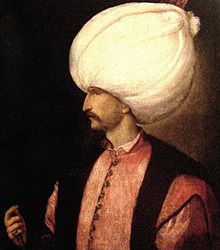
especially in India, where attacks became more frequent. The expense of defending Indian interests was huge. To pay for it, João III abandoned a number of strongholds in North Africa: Safim, Azamor, Alcácer Ceguer and Arzila.
João III achieved an important political victory in securing the control of the Maluku Islands, the "Spice Islands" claimed by Spain since the Magellan-Elcano circumnavigation. After almost a decade of skirmishes in Southeast Asia, he signed the Treaty of Zaragoza with Emperor Charles V on 22 April 1529. It defined the areas of Spanish and Portuguese influence in Asia and established the anti-meridian to the Treaty of Tordesillas.
The reign of João III was marked by active diplomacy. With Spain, he made alliances through marriage that ensured peace in the Iberian Peninsula for a number of years. He himself married Catherine of Austria, the daughter of Philip I of Castile. His sister Isabel of Portugal married Charles V, the king of Spain and Holy Roman Emperor. His daughter Maria Manuela

married King Felipe II of Spain

– and there were others. However, the intermarriage of these closely related royal families may have been one of the factors that contributed to the poor health of João's children and of future King Sebastião of Portugal.
João III remained neutral during the war between France and Spain but stood firm in fighting the attacks of French privateers.
He strengthened relations with the Papal States by introducing the Inquisition in Portugal and the adhesion of the Portuguese clergy to the Counter-Reformation. This relationship with the Catholic Church made it possible for João to name whomever he desired to important religious positions in Portugal: his brothers Henrique and Afonso
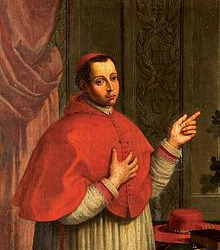
were made Cardinals, and his biological son, Duarte; was made Archbishop of Braga.
Commercial relations were intensified with England, the countries of the Baltic regions and Flanders during João III's reign. Meanwhile, at the other end of the world, Portugal was the first European nation to make contact with Japan. In China, Macau was offered to the Portuguese, and soon Portugal controlled major trade routes in the area. In South Asia, the Portuguese continued its hostile stance against their Muslim rivals and insurgent Indian leaders.
João III's support for the humanist cause was significant. In literature, his active support of Gil Vicente,
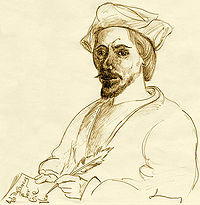
Garcia de Resende,

Sá de Miranda,

Bernardim Ribeiro,
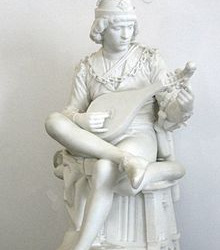
Fernão Mendes Pinto,

João de Barros
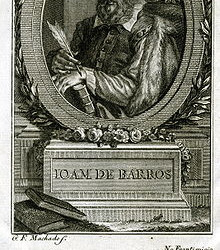
and Luís de Camões
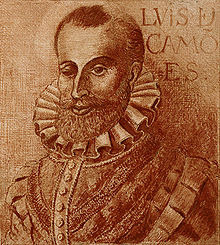
was notable. In the sciences, João III supported the mathematician Pedro Nunes
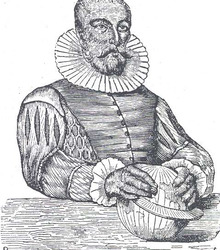
and the physician Garcia de Orta.

Through his links to Portuguese humanists such as Luís Teixeira Lobo, Erasmus dedicated his Chrysostomi Lucubrationes to João III of Portugal in 1527.
The monarch awarded many scholarships to universities abroad, mainly in the University of Paris, where fifty Portuguese students were sent to the Collège Sainte-Barbe headed by Diogo de Gouveia. He definitively transferred the Portuguese university from Lisbon to Coimbra in 1537.

In 1542 João III created in Coimbra a College of Arts (Liberal arts) for which he quickly recalled the many prominent Portuguese and European teachers headed by André de Gouveia at the College of Guienne in Bordeaux. Those included George Buchanan,
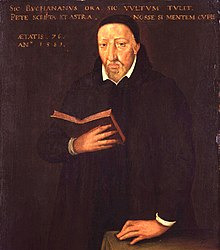
Diogo de Teive, Jerónimo Osório, Nicolas de Grouchy, Guillaume Guérante and Élie Vinet, who were decisive for the dissemination of the contemporary research of Pedro Nunes. The king provided the university with excellent resources. However, the importance of the College was shadowed by rivalry between the orthodox views of the "Parisians" group headed by Diogo de Gouveia and the more secular views of the "Bordeaux" school headed by his nephew André de Gouveia, within the advent of the Counter-Reformation and the influence of the Society of Jesus. The Society of Jesus founded colleges and made education more widely available.
Another noteworthy aspect of João III's rule was the support he gave to missionaries in the New World, Asia and Africa. In 1540, after successive appeals to Pope Paul III asking for missionaries for the Portuguese East Indies under the "Padroado" agreement, João III appointed Francis Xavier to take charge as Apostolic Nuncio. He had been enthusiastically endorsed by Diogo de Gouveia, his teacher at the Collège Sainte-Barbe, and advised the king to draw the youngsters of the newly formed Society of Jesus.The Jesuits were particularly important for mediating Portuguese relations with native peoples.
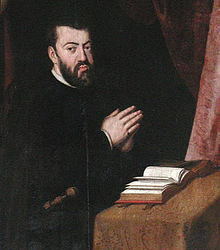
The Inquisition was introduced into Portugal in 1536. As in Spain, the Inquisition was placed under the authority of the king.
The Grand Inquisitor, or General Inquisitor, was named by the Pope after being nominated by the king, and he always came from within the royal family. The Grand Inquisitor would later nominate other inquisitors. In Portugal, the first Grand Inquisitor was Cardinal Henrique the king's brother (who would later himself become king).
There were Courts of the Inquisition in Lisbon, Coimbra and Évora and, from 1560 onwards, in Goa. The Goa Inquisition changed the demographics of Goa considerably. Goa was called the "Lisbon of the Far East" and trade reached a new level.
The Portuguese did not leave Goa undeveloped, rather they introduced modern architecture and built strong roads and bridges that have stood the test of time even till today.
The activities of the Inquisition extended to book censorship, repression and trial for divination, witchcraft and bigamy, as well as the prosecution of sexual crimes, especially sodomy.
Originally created to punish religious deviance, the Inquisition came to have influence in almost every aspect of Portuguese society: politics, culture and social customs. It did serve to spare Portugal the civil upheavals of religious warfare of the sort that occurred in France and elsewhere in Europe during the 16th century.

In João III's time, trade between the Portuguese and Africans was extremely intense in feitorias such Arguim, Mina, Mombasa, Sofala or Mozambique. Under João III, several expeditions started in coastal Africa and advanced to the interior of the continent. These expeditions were formed by groups of navigators, merchants, adventurers and missionaries. Missions in Africa were established by the College of Arts of Coimbra. The objective was to increase the king's dominion, develop peaceful relations and to Christianize the indigenous peoples. Relations with local rulers were often complicated by trade in slaves, as shown by João's correspondence with them.
João III refused to abandon all of the Portuguese North African strongholds, but he had to make choices based on the economic or strategic value of each possession. João III decided to abandon Safim and Azamor in 1541, followed by Arzila and Alcácer Ceguer in 1549. The fortresses of Ceuta, Tangiers and Mazagan were strengthened "to face the new military techniques, imposed by the generalization of heavy artillery, combined with light fire weapons and blades".
João III's court jester was João de Sá Panasco, a black African, who was eventually admitted to the prestigious Order of Saint James based on his service in the Conquest of Tunis (1535).
Before the reign of João III, the Portuguese had already reached Siam (1511), the Maluku Islands (1512), the Chinese littoral (1513), Canton (1517) and Timor (1515). During João's rule, the Portuguese reached Japan, and at the end of João's reign, Macau was offered to Portugal by China. From India, João III imported an amazing variety of spices, herbs, minerals, and fabrics; from Malacca, exotic woods and spice; from Bengala, fabrics and exotic foodstuffs; from Alexandria and Cairo, exotic woods, metals, minerals, fabrics, and boullion; and from China, musk, rhubarb, & silk in exchange for gromwells, pearls, horses from Arabia and Persia, non-worked silk, silk embroidery threads, fruits of the date palm, raisins, salt, sulphur and many other goods.
As Muslims and other peoples constantly attacked Portuguese fleets in India, and because India was so far from mainland Portugal, it was extremely difficult for João III to secure Portuguese dominion in this area. A viceroy (or Governor-General with extensive powers) was nominated, but this was not enough to defend the Portuguese possessions in India. The Portuguese started by creating feitorias – commercial strongholds in Cochin, Cannanore, Coulão, Cranganore and Tanor – with the initial objective of establishing just a commercial dominion in the region.
The hostility of many Indian kingdoms and alliances between sultans and zamorins to expel the Portuguese made it necessary for the Europeans to establish a sovereign state. Portugal thus militarily occupied some key cities on the Indian coast, and Goa became the headquarters of the Portuguese Empire in the East as of 1512. Goa became a starting point for the introduction of European cultural and religious values in India, and churches, schools and hospitals were built. Goa remained an overseas possession of Portugal until India reclaimed it in 1961.
The Portuguese arrived in Japan in 1543. Japan had been known in Portugal since the time of Marco Polo,

who called it "Cipango". Whether Portuguese nationals were the first Europeans to arrive in Japan is debatable. Some say the first Portuguese arrival was the writer Fernão Mendes Pinto, and others say it was the navigators António Peixoto, António da Mota and Francisco Zeimoto.
Portuguese traders started negotiating with Japan earlier than 1550 and established a base there at Nagasaki. By then, trade with Japan was a Portuguese monopoly under the rule of a Captain. Because the Portuguese established themselves in Macau, Chinese commercial relations, mainly the silver trade with Japan, were improved under João III's rule.
After the voyage of Fernão de Magalhães
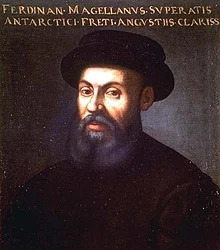
the Crown of Castile claimed the recently discovered Maluku Islands. In 1524, a conference of experts (cartographers, cosmographers, pilots, etc.) was held to solve the dispute caused by the difficulty of determining the meridian agreed to in the Treaty of Tordesillas. The Portuguese delegation sent by João III included names such as António de Azevedo Coutinho, Diogo Lopes de Sequeira, Lopo Homem and Simão Fernandes. The dispute was settled in 1529 by the Treaty of Zaragoza, signed by João III and Carlos I of Spain. The Portuguese paid 350,000 gold ducados to Spain and secured their presence in the islands, which not have been a necessity, as Portugal was actually entitled to the islands according to the Treaty of Tordesillas.
In 1553, Leonel de Sousa obtained authorization for the Portuguese to establish themselves in Canton and Macau. Macau was later offered to João III as a reward for Portuguese assistance against maritime piracy in the period between 1557 and 1564. Malacca, which controlled the eponymous Strait of Malacca, was vital to Portuguese interests in the Far East. After an unsuccessful expedition in 1509, Malacca was finally conquered by Afonso de Albuquerque, the Portuguese viceroy of India, on 24 August 1511. Malacca was later taken by the Dutch in 1641.
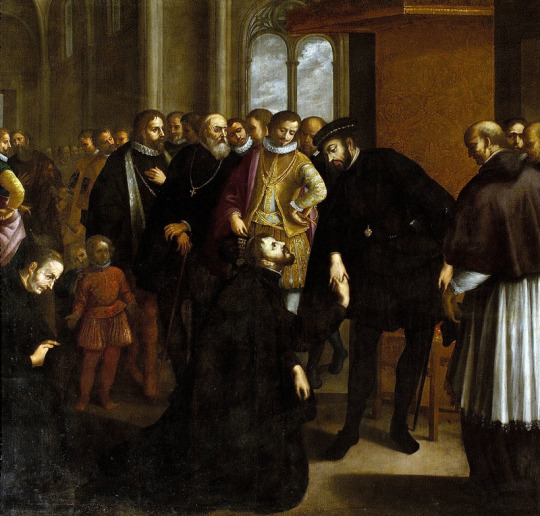
In order to follow its trade routes to the Far East, Portugal depended on the seasonal monsoon winds in the Indian Ocean. In winter, the prevailing northeasterly monsoon impeded travel to India; in summer, the southwest monsoon made departure from India difficult. As a result, Portugal determined that it needed permanent bases in India, in addition to its ports of call in Africa, to pass the time while the wind changed. In addition to Goa, they established themselves in Ceylon (in what is now Sri Lanka) through the conquest of several Ceylonese kingdoms in the sixteenth century. Portuguese Ceylon remained in Portuguese hands until 1658, when it was seized by the Dutch after an epic siege.
During the reign of King João III, the Portuguese Empire established itself in South America with the foundation of the twelve Captaincy Colonies of Brazil (from 1534 onwards). Each with its own donatary captain, the twelve colonies struggled independently. In 1549, João III established the Governorate General of Brazil, and the twelve captaincy colonies became subordinate to it. The first Governor-General appointed by João III, Tomé de Sousa, founded the city of Salvador, Bahia (São Salvador da Bahia de Todos os Santos) in 1549.
Immediately following the discovery of Brazil in 1500, the Portuguese imported brazilwood, Indian slaves and exotic birds from there. Brazilwood was a much appreciated product in Europe, because it could be used to produce a red dye. During João III's rule, after the initial colonization, Portuguese explorers intensified the search for brazilwood and began the cultivation of sugarcane, which was well suited to the climate of Brazil, especially around Recife and Bahía.
In the final years of João's reign, Portugal's colony of Brazil was just beginning its rapid development as a producer of sugar that compensated for the gradual decline of revenues from Asia, a development that would continue during the reign of his grandson and successor, Sebastião (1557–1578). Since Brazil lacked a large native population, and the Indians did not make good plantation workers, the Portuguese colonists began to import African slaves to work their plantations. The first slaves, from the region of Guinea, arrived in Brazil in 1539. Most of them worked in the sugarcane fields or served as house servants.
From 1539, the heir to the throne was João Manuel, Prince of Portugal,

who married Joana of Austria, Princess of Portugal,

daughter of Charles V. The sole son of João III to survive childhood, Prince João, was sickly and died young (of juvenile diabetes), eighteen days before his wife gave birth to Prince Sebastião on 20 January 1554. When João III died of apoplexy in 1557, his only heir was his three-year-old grandson, Sebastião. João III's body rests in the Monastery of Jerónimos in Lisbon, next to his wife.
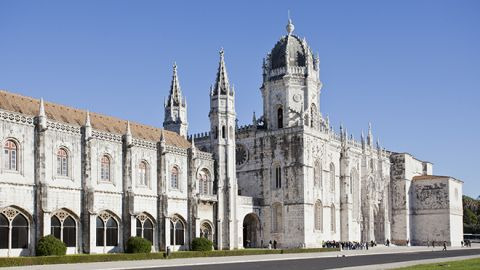

With his wife Catarina of Austria (married 10 February 1525) he had 9 nine children:
Prince Afonso (24 February 1526 - March 1526) Prince of Portugal (1526).
Princess Maria Manuela (15 October 1527 - 12 August 1545) Princess of Portugal (1527–1531). Princess consort of Asturias by marriage to King Philip II of Spain, then Prince of Asturias. She had one deformed child, Prince Carlos, and she died a few days after his birth.
Infanta Isabel (28 April 1529 - 28 April 1529)
Infanta Beatriz (15 February 1530 - 15 February 1530)
Prince Manuel (1 November 1531 - 14 April 1537) Prince of Portugal (1531–1537). Declared heir in 1535.
Prince Filipe (25 March 1533 - 29 April 1539) Prince of Portugal (1537–1539). Declared heir in 1537.
Infante Dinis (6 April 1535 - 1 January 1537)
Prince João Manuel (3 June 1537 - 2 January 1554) Prince of Portugal (1537–1554). Declared heir in 1539. Married Joana of Spain. Their son became King Sebastião I.
Infante António (9 March 1539 - 20 January 1540)
8 notes
·
View notes
Text
Liga LIVRES divulga a capa do álbum dos sambas-enredos do Carnaval 2023
Liga LIVRES divulga a capa do álbum dos sambas-enredos do Carnaval 2023 A Liga Independente Verdadeira Raízes das Escolas de Samba (LIVRES) acaba de divulgar a capa do álbum dos sambas-enredos das escolas de samba do Grupo B, que desfilarão na Intendente Magalhães, no dia 26 de fevereiro de 2023. A apresentação dos hinos oficiais das escolas de samba União de Vaz Lobo, Mocidade Independente…

View On WordPress
0 notes